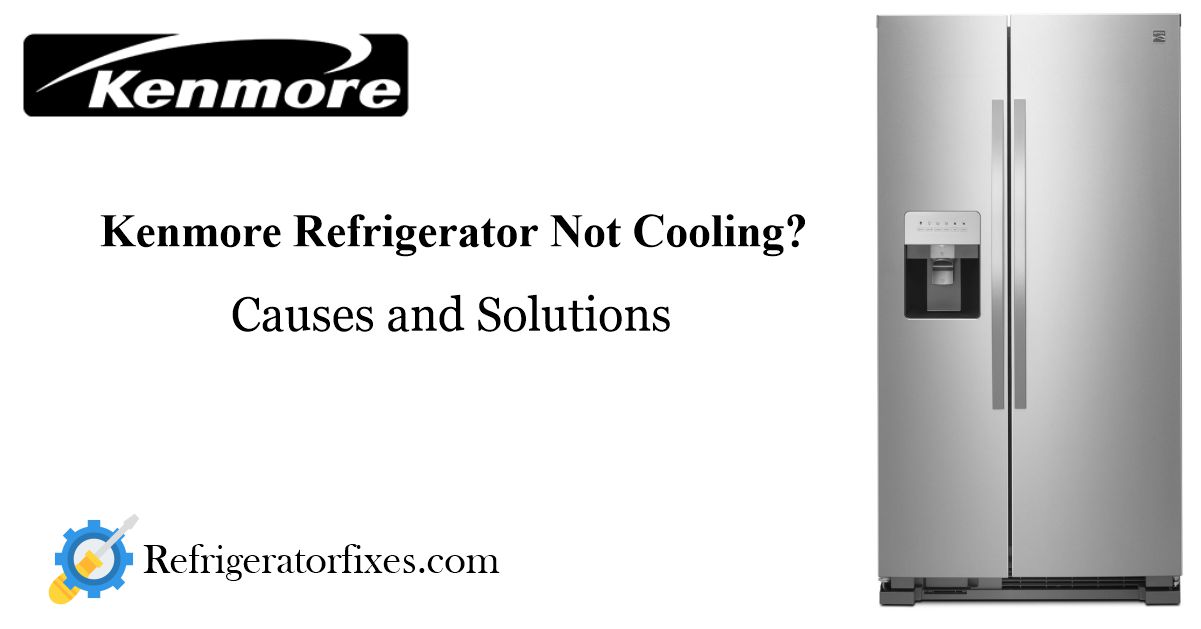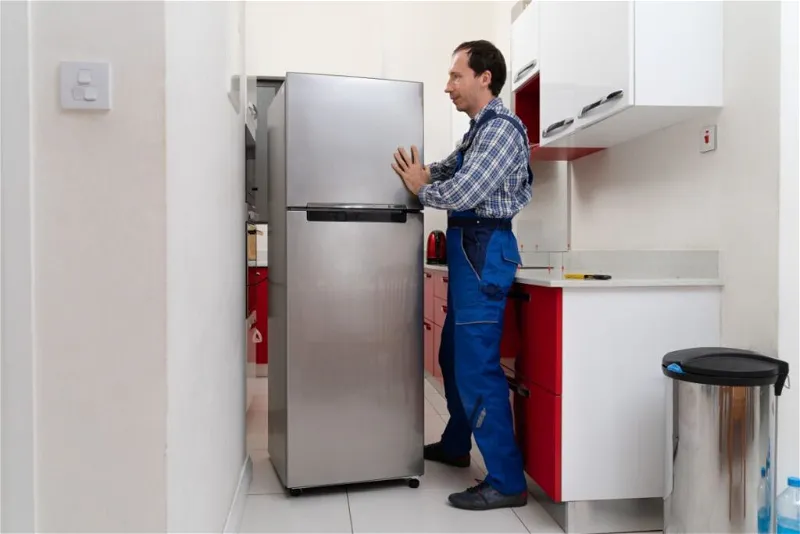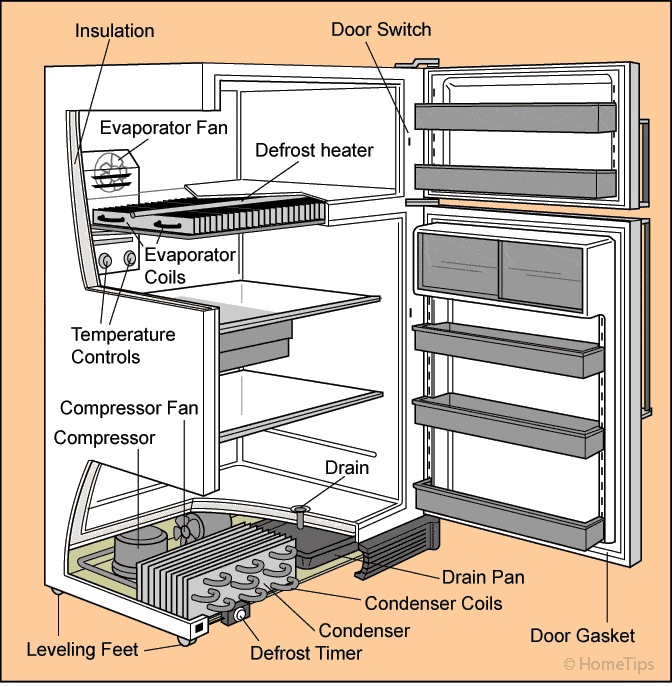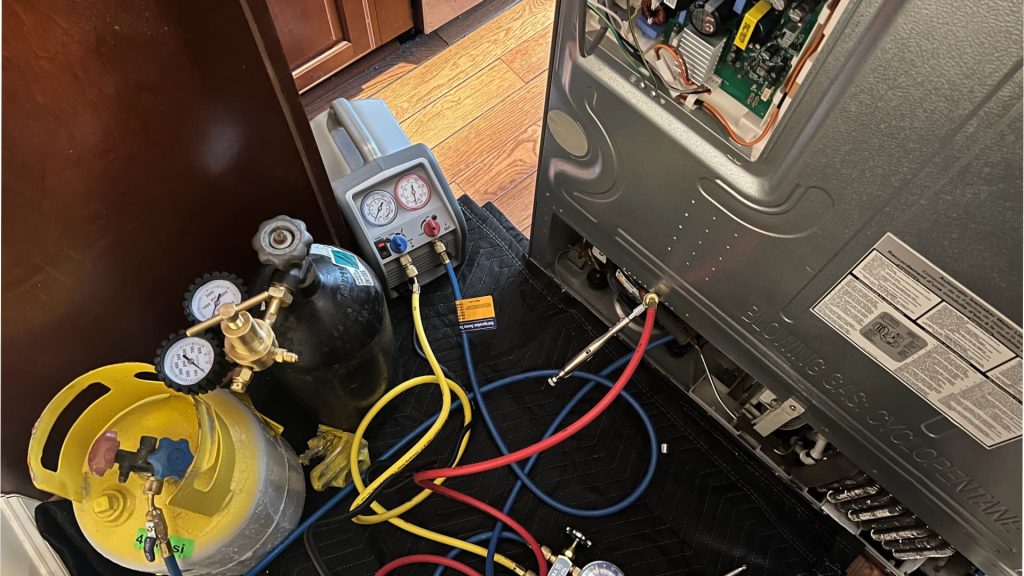Kenmore Refrigerator Not Cooling (Quick Fix)

Is your Kenmore refrigerator not cooling as it should? Don’t worry, you’re not alone. Many Kenmore refrigerator owners face this common issue at some point. The good news is that in most cases, the problem can be resolved with a few simple steps. In this comprehensive troubleshooting guide, we will walk you through the process of diagnosing and fixing the cooling issues in your Kenmore refrigerator.
READ ALSO: Bosch Refrigerator Not Cooling (Quick Fix)
The Kenmore brand was first introduced in 1913 as a line of sewing machines sold by Sears. In 1927, Kenmore launched its first washing machine, which was followed by other laundry appliances, vacuum cleaners, and dishwashers. In 1976, Sears expanded the Kenmore name to its line of refrigerators, freezers, air conditioners, and dehumidifiers, which were previously branded as Coldspot.
Kenmore has been a leader in innovation and technology in the home appliance industry. Some of its notable achievements include:
- The Gyrator wringer washer in 1936, which promised to wash clothes clean in 3-7 minutes.
- The Toperator in 1940, which automated the laundry process and led to the milestone of selling one million laundry products in 1949.
- The Harmony House line in 1954, which revolutionized home décor with products featuring the latest design and technology in vibrant colors.
- The TurboMatic in 1957, the first washer-dryer combination, which shook up the laundry market.
- The microwave oven in 1971, which introduced a new way of cooking and heating food.
- The Sensor Sew One Hundred in 1978, which featured a revolutionary design and solid-state controls.
- The Prestige Collection in 1985, which made a style splash with white-on-white and black-on-black appliances.
- The Elite HE3t washer in 2001, which debuted with the greatest water and energy efficiency of any U.S. brand.
- The Grab-N-Go™ door in 2012, which opened up a whole new world of storage space with this industry-first innovation in refrigeration.
Kenmore has also been a part of American pop culture and history. For example, Donna Reed played a happy homemaker on TV with Kenmore appliances in the 1950s. The Trumans purchased a Kenmore washing machine in 1953. A 1940s Kenmore washing machine was chosen by Cooper-Hewitt National Design Museum for its “Milestones: 50 Years of Goods and Services” exhibit in 1992.
Today, Kenmore continues to offer a wide range of appliances that are trusted and loved by millions of American households. Kenmore has also expanded its online presence with Cookmore.com, a platform that provides recipes, cookbooks, meal planners, and grocery lists, as well as offering grand contests and offers. Kenmore also dominates in capacity with models in cooking, laundry, and refrigeration, such as the 33 cu. ft. Kenmore Elite French Door Refrigerator, which offers more capacity than any other refrigerator.
Kenmore has had a long and remarkable journey since its inception over a century ago. It has become synonymous with reliability and innovation in the world of home appliances. Kenmore has had a lasting impact on American households, making their lives easier, better, and more enjoyable.
READ ALSO: How to Troubleshoot and Fix a KitchenAid Refrigerator Not Cooling
Safety Precautions

Before we begin, it’s important to prioritize safety. Always remember to follow these essential safety precautions when working on your Kenmore refrigerator:
- Disconnect the appliance from the power source to avoid electric shock.
- Read all warning labels and instructions carefully.
- Use appropriate tools and protective gear.
- If unsure or uncomfortable with any step, consult a professional technician.
CHECK OUT: How to Troubleshoot and Fix a Frigidaire Refrigerator Not Cooling
Common Causes of Kenmore Refrigerator Not Cooling

Before we delve into the troubleshooting steps, let’s take a look at some common causes of a Kenmore refrigerator not cooling properly. Understanding these causes will help you identify the root of the problem and take appropriate action.
- Dirty Condenser Coils: The condenser coils are responsible for dissipating heat from the refrigerator. If they are clogged with dirt and debris, the refrigerator will struggle to cool effectively.
- Faulty Thermostat: The thermostat controls the temperature inside the refrigerator. If it is malfunctioning, the refrigerator may not cool to the desired temperature.
- Defective Evaporator Fan: The evaporator fan circulates cold air throughout the refrigerator. If it stops working, the refrigerator will not cool properly.
- Blocked Air Vents: Air vents allow for proper airflow inside the refrigerator. If they are blocked by food or other obstructions, the refrigerator may not cool evenly.
Now that we have an understanding of the potential causes, let’s dive into the troubleshooting steps to get your Kenmore refrigerator cooling again.
READ: How to Troubleshoot and Fix a Whirlpool Refrigerator Not Cooling
Troubleshooting Steps

Step 1: Clean the Condenser Coils
One of the most common reasons for a Kenmore refrigerator not cooling is dirty condenser coils. Over time, dust and debris can accumulate on the coils, hindering their ability to dissipate heat effectively. To clean the condenser coils, follow these steps:
- Unplug the refrigerator: Safety first! Before starting any maintenance or cleaning, make sure to unplug the refrigerator from the power source.
- Locate the condenser coils: Depending on the model of your Kenmore refrigerator, the condenser coils can be found either at the back or underneath the refrigerator, behind a panel.
- Remove the panel: If the coils are located at the back, remove the back panel by unscrewing the screws. If they are underneath, remove the kickplate at the front to access the coils.
- Clean the coils: Use a condenser brush or a soft brush attachment on a vacuum cleaner to gently remove dust and debris from the coils. Make sure to clean both the back and front coils thoroughly.
- Reassemble the refrigerator: Once the coils are clean, reattach the panel or kickplate and plug the refrigerator back in.
READ: LG Refrigerator Not Cooling: Causes and Solutions
Step 2: Check the Thermostat

If cleaning the condenser coils doesn’t solve the cooling issue, the next step is to check the thermostat. Here’s what you need to do:
- Locate the thermostat: The thermostat is usually located inside the refrigerator, near the top or on the side wall.
- Check the temperature settings: Ensure that the temperature control settings are set correctly. Sometimes, the thermostat can be accidentally adjusted or bumped, leading to improper cooling.
- Test the thermostat: If the temperature settings are correct, but the refrigerator is still not cooling, you may need to test the thermostat for proper functioning. This requires using a multimeter to check for continuity. If there is no continuity, the thermostat may need to be replaced.
Step 3: Inspect the Evaporator Fan
The evaporator fan plays a crucial role in circulating cold air throughout the refrigerator. If it stops working, the refrigerator will not cool properly. Follow these steps to inspect the evaporator fan:
- Locate the evaporator fan: The evaporator fan is typically located in the freezer compartment, behind a panel.
- Check for obstructions: Remove the panel and inspect the fan for any obstructions, such as ice buildup or debris. Clear any blockages that may be hindering the fan’s operation.
- Test the fan: With the refrigerator plugged in, manually spin the fan blades. If the fan does not spin freely or makes unusual noises, it may be defective and need to be replaced.
Step 4: Ensure Proper Air Ventilation
Blocked air vents can disrupt the airflow inside the refrigerator, leading to uneven cooling. Follow these steps to ensure proper air ventilation:
- Check for obstructions: Inspect the air vents in both the refrigerator and freezer compartments for any obstructions, such as food items or packaging. Clear away any obstacles to allow for proper airflow.
- Rearrange items: Avoid overcrowding the refrigerator and freezer compartments. Ensure that there is enough space around the items to allow for proper air circulation.
- Check door seals: Damaged or worn-out door seals can also cause cooling issues. Inspect the door gaskets and make sure they are properly sealing the doors. If you notice any gaps or tears, replace the door seals.
READ: GE Refrigerator Not Cooling: Causes and Solutions
Testing and Fine-Tuning
Now that you’ve completed the necessary repairs, it’s time to test the refrigerator and make any final adjustments:
- Turn on the refrigerator with the recommended settings for the freezer and refrigerator compartments.
- Monitor the cooling performance to ensure everything is working correctly.
- If the issue persists or you notice any other problems, consult a professional technician for further assistance.
By following these troubleshooting steps, you should be able to pinpoint and resolve the cooling issues in your Kenmore refrigerator. However, if the problem persists or if you are uncomfortable performing these repairs yourself, it is recommended to seek the assistance of a professional technician.
READ ALSO: How to Troubleshoot and Fix a Samsung Refrigerator Not Cooling
Conclusion
A Kenmore refrigerator not cooling can be a frustrating issue, but with the right troubleshooting steps, you can quickly diagnose and fix the problem. Remember to clean the condenser coils, check the thermostat, inspect the evaporator fan, and ensure proper air ventilation. By addressing these common culprits, you can restore the cooling functionality of your Kenmore refrigerator and keep your food fresh and cool.
Additional Information: It is important to regularly maintain your Kenmore refrigerator by cleaning the condenser coils every six months and checking the door seals for any signs of wear and tear. This will help prevent future cooling issues and ensure optimal performance of your refrigerator.
FAQs
My Kenmore refrigerator isn’t cooling! What could be wrong?
Several things could be causing your refrigerator not to cool. Here are the most common culprits:
– Dirty condenser coils: These coils release heat, and if they’re clogged with dust and debris, the fridge can’t cool effectively.
– Faulty door gasket: A damaged or worn-out gasket allows warm air to leak in, making the refrigerator work harder to maintain temperature.
– Temperature setting: Make sure the thermostat is set to the correct temperature for both the freezer and refrigerator compartments.
– Defrost system issues: A buildup of ice on the evaporator coils can prevent proper cooling.
– Faulty components: The compressor, condenser fan, evaporator fan, or other components may have malfunctioned.
How can I troubleshoot the problem myself?
You can try some basic troubleshooting steps before calling a repair technician:
– Clean the condenser coils: Gently vacuum the coils located at the bottom of the refrigerator, back near the compressor.
– Inspect the door gasket: Check for damage or tears and replace it if necessary.
– Verify the temperature settings: Ensure they are set correctly for both compartments.
– Listen for unusual sounds: If you hear clicking, buzzing, or humming noises, it could indicate a component malfunction.
What if the problem persists?
If the troubleshooting steps don’t fix the issue, it’s best to call a qualified appliance repair technician. They can diagnose the problem and recommend the appropriate repair.
How often should I clean the condenser coils?
Ideally, every 3-6 months, depending on your environment and usage.
Can I replace the door gasket myself?
Yes, replacement gaskets are typically available online or at appliance parts stores.
How much does it cost to repair a Kenmore refrigerator?
The cost depends on the specific problem and the required repairs. Simple fixes can be affordable, while major component replacements may be more expensive.
Always unplug your refrigerator before performing any troubleshooting or repairs.
Disclaimer: This information is for general informational purposes only and is not a substitute for professional diagnosis and repair. Always consult a qualified appliance repair technician for complex issues or electrical work.